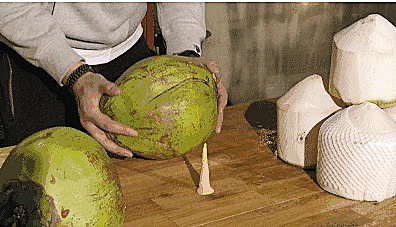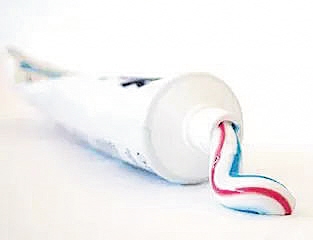Surprised! What is the principle that chewing gum can open coconuts?

Can chewing gum really open coconuts by rubbing it into a cone? (Video screenshot)

The scorching summer is a good time to drink coconut milk and eat coconut meat. Here is an interesting question: If you only have durian, rubber band and chewing gum at hand, which one do you think you can choose to open a coconut quickly?
You may not imagine that researchers will tell you that opening coconuts with chewing gum is one of the simplest and most feasible methods.
If you want to know the principle, you need to know all kinds of substances of non-Newtonian fluid and Newtonian fluid.
Inflatable fluid: eat soft but not hard
— — Chewing gum, starch solution, wet sand on the beach and concrete slurry belong to expansive fluids.
What is the correct posture to open coconuts with chewing gum?
First, knead a few pieces of chewing gum into a cone, then put the tip up and the bottom flat on the table, then hold the coconut to a certain height with your hands and hit it hard on the chewing gum. We will find that chewing gum will not be smashed flat, but will break a hole in the coconut. Repeat this several times, and the coconut can be broken.
Why on earth does chewing gum have such magical power? In fact, the principle is — — Non-newtonian fluid principle. There is a gum-based component in chewing gum, which belongs to the shear thickening fluid in non-Newtonian fluid. The viscosity of this fluid will increase under the action of a large external force, and the greater the external force, the greater the viscosity.
When the coconut hits the chewing gum at high speed, the viscosity of the chewing gum increases rapidly, and at this time it behaves as hard as a solid, thus piercing the hard shell of the coconut. Once the external force is withdrawn, it will return to the nature of liquid. If the external force is small and slow, it will behave like an ordinary liquid with fluidity. It’s really a soft guy.
When this fluid thickens, its volume will expand slightly, so the shear thickening fluid is also called expansive fluid. Starch solution, wet sand on the beach and concrete slurry all belong to this kind of fluid.
The change of viscosity of expansive fluid is related to its internal structure. That is, when shear thickening occurs, a certain structure is formed inside the fluid.
Expansive fluid is usually a multiphase mixture, such as wet sand on the beach, which is a mixture of sand and water. When there is no external force or the external force is very small, the irregular sand grains are densely packed, and water can be evenly filled in the gaps between the sand grains to play the role of lubricant. When someone steps on the sand, the original tightly packed structure is destroyed, and the "dislocation" between the sand grains will increase the volume; At the same time, the water is forced to move around, and the flow is disordered, and the resistance will increase, and the flow of sand is more difficult because of the loss of lubricant. Therefore, the sand surface infiltrated by seawater on the beach is easier to walk than dry sand, because this characteristic of wet sand will make our feet less prone to sink.
Bingham fluid: sometimes like a solid, sometimes like a liquid.
— — Toothpaste, facial cleanser and hand cream belong to Bingham fluid.
Since there is non-Newtonian fluid, there must be Newtonian fluid. Fluids whose shear stress and shear rate conform to Newtonian fluid formula belong to Newtonian fluid. Water and air are Newtonian fluids, and their shear stress is directly proportional to the shear rate.
Any fluid whose shear force and shear rate do not conform to Newtonian fluid formula is called non-Newtonian fluid. Besides expansive fluid, non-Newtonian fluid also includes pseudoplastic fluid and Bingham fluid. All kinds of sauces, oils, polymer solutions, mud in the kitchen, and even blood and cell fluids in organisms are non-Newtonian fluids.
The shear stress and shear rate of Bingham fluid are also linear, but unlike Newtonian fluid, it has a yield stress, and it will flow only when the external force is greater than the yield stress.
The most typical Bingham fluid is toothpaste. When there is no external force, it looks like a solid. Only when we squeeze toothpaste hard, it will "flow" out of the tube, and when it is squeezed into the toothbrush, it can still maintain a certain shape without "falling down". If you don’t squeeze it, it won’t come out even if you turn the toothpaste tube upside down.
Similarly, we can infer that things like facial cleanser and hand cream are also Bingham fluids. The paint used in buildings also needs to be designed as Bingham fluid. We require that it can flow when mixing and painting, and at the same time, it will not flow down from the wall because of gravity after being painted on the wall, that is to say, the yield stress of the paint should be greater than its own gravity.
Like expansive fluid, Bingham fluid is a multiphase mixture. It is generally believed that the fillers in Bingham fluid form a three-dimensional network structure, which has certain strength and can resist low external forces; When the external force is large enough, the three-dimensional structure is destroyed and the filler will flow with the solvent.
Pseudoplastic fluid: bullying the weak and fearing the hard.
— — Blood, magma, yogurt, tomato sauce and shampoo are pseudoplastic fluids.
If expansive fluid is soft and hard, then pseudoplastic fluid is a bully. Pseudo-plastic fluid shows the opposite properties to dilatant fluid, and its viscosity remains constant at low shear rate, but decreases with the increase of shear rate. That is to say, the greater the external force applied to it, the smaller the viscosity it shows. So it is also called shear thinning fluid.
Many polymer liquids belong to this kind of fluid. The viscosity of a fluid can be understood as the friction between molecules in the fluid, and the greater the friction, the greater the viscosity. Solute in polymer liquid is a kind of molecule with large molecular mass and long structure. Without external force, they are usually in a curled state, and the molecules may entangle and collide with each other, resulting in high friction. When there is an external force, the curled molecules will spread along the direction of shear force, and the molecules will be arranged in parallel, so the friction between them will be reduced, and thus the viscosity will be reduced.
Blood, magma, yogurt, tomato sauce and shampoo all belong to pseudoplastic fluids. When we stir yogurt or tomato sauce slowly, we will find it more difficult, but when we stir it quickly, it will be easier. In fact, this is the reason above.
Pseudoplastic fluid has another interesting phenomenon — — Kay effect. When a beam of pseudoplastic fluid with high viscosity hits a solid surface, the solid surface will bounce the liquid beam back upward.
Observing the experimental phenomenon carefully, it is not difficult to find that a layer of fluid always accumulates below the rebounding water flow. Combined with the properties of pseudoplastic fluid, the whole process should be like this: the rapidly falling liquid jet impacts the viscous fluid pile below, and the viscosity of the fluid surface becomes smaller due to the impact force, forming a dimple-shaped pit after the impact. At the same time, the surface with reduced viscosity acts as a lubricant, and finally the falling liquid jet is bounced out.
(Cai Dongmin)